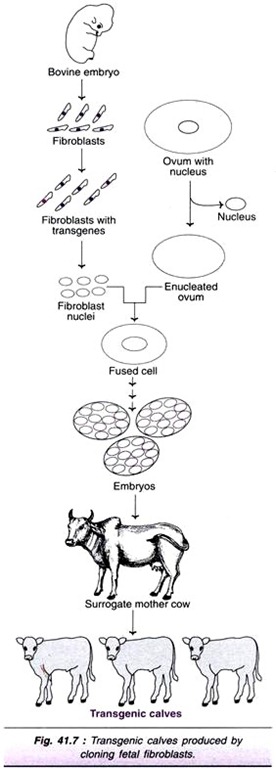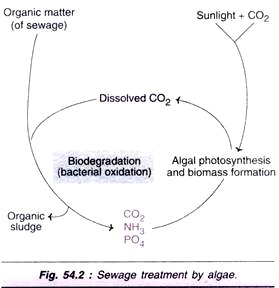ADVERTISEMENTS:
The nervous system of man and other group of vertebrates is divided into three main parts:
1. Central nervous system (CNS) comprising brain and spinal cord.
2. Peripheral nervous system (PNS) consisting of cranial and spinal nerves.
ADVERTISEMENTS:
3. Autonomic nervous system (ANS) including sympathetic and parasympathetic nerves.
Central Nervous System (C.N.S.) (Coloured Plate-I and II):
Structure:
It is the most complicated and highly specialized organ of the body. An adult human brain weighs about 1400 gms. (In a new born baby it is about 400 gms and becomes double after one year) and has a volume of about 1500 c.c. It is enclosed in a bony case called cranium which protects brain against external injury.
(a) Meninges. The brain is being surrounded by three membranes called meninges (sing-meninx).
ADVERTISEMENTS:
The meninges are:
(i) Outer duramater is a tough white membrane present below the cranium.
(ii) Middle arachnoid layer having a net work of Fibres.
(iii) Inner piamater is a thin, transparent, and vascular membrane close to the surface of brain and spinal cord. At two places the piameter fuses with the thin, dorsal surface of the brain to form choroid plexus. The meninges protect the brain from external shock.
The space between duramater and arachnoid is the subdural space and the space between arachnoid and piamater is known as subarachnoid space (Fig. 1.3). These spaces surrounding the brain as well as the cavities within the brain are filled with a lymphatic fluid, called cerebrospinal fluid (CSF). The cerebrospinal fluid is also present within the spinal cord.
Function:
The cerebrospinal fluid protects the central nervous system from external shock; helps in exchange of nutrients and waste products between the nervous tissue and blood and maintains a constant pressure in and around the brain. The brain is formed of two types of nervous tissue, Grey matter on the outer side and White matter on the inner side. The former is made of non-medullated nerve cells whereas the latter is formed of medullated nerve cells. The brain or encephalon is a white, bilaterally symmetrical structure.
It is divided into three main parts: (Fig. 1.4 and Fig. 1.5)
1. Fore brain or Prosencephalon
ADVERTISEMENTS:
2. Mid brain or Mesencephalon
3. Hind brain or Rhombencephalon
Fore Brain:
ADVERTISEMENTS:
It is the anterior part of the brain and largest among the three parts.
It consists of three parts:
a. Olfactory lobes,
b. Cerebral hemispheres and
ADVERTISEMENTS:
c. Diencephalon.
(a) Olfactory Lobes:
The anterior most part of the fore brain is a pair of olfactory lobes. They consist of an anterior club shaped olfactory bulb and posterior olfactory tract. The cavity of the olfactory lobes or rhinocoel is not well marked. (Fig. 1.5) The olfactory lobes of human being are not significantly developed as seen in lower vertebrates. The olfactory lobes are the centers of smell.
(b) Cerebral Hemispheres:
ADVERTISEMENTS:
The cerebral hemispheres or cerebrum is the largest part of the brain occupying about two-third of the entire brain. It is divided into right and left cerebral hemispheres by a deep longitudinal median groove (Fig. 1.6 and Fig. 1.7).
These two cerebral hemispheres are connected by a transverse sheet of nerve fibres, called corpus callosum (Fig. 1.12 & 1.13). The anterior part of corpus callosum is bent slightly downward to form genu while the posterior part is raised upward to form splenium. The cerebral hemispheres are divided by 3 deep fissures into 4 lobes viz. frontal, parietal, temporal and occipital lobes (Fig. 1.8).
Each lobe has its own specific function.
ADVERTISEMENTS:
The frontal lobe has two areas:
(a) Motor area, controls the voluntary movements of the muscles,
(b) Premotor area, controls the involuntary movements of muscles and the same of the autonomic nervous system.
The parietal lobe or the somaestic area is the centre for the perceptions of sensations like pain, touch and temperature. The occipital lobe has two areas viz., the visual area for visual sensations and auditory area for hearing sensations. On the ventral side there is a longitudinal fissure called rhinal fissure which separates the hippocampal lobe or pyriform lobe from anterior lobe in each cerebral hemisphere. Insula or Island of Reil is a small lobe of cerebrum, covered over by parietal frontal, and temporal lobes. It co-ordinates the action of different regions of cerebral hemispheres.
The outer layer of cerebral hemispheres is called cerebral cortex or neopallium. It is formed of grey matter and contains millions of neurons. Grey matter also forms islands on the white matter. These are called cerebral nuclei. The cerebral cortex is highly convulated in order to increase its surface area.
The ridges of these convultions are called gyri and depressions between them as sulci. The cavities within the cerebral hemispheres are called lateral ventricles (First and second ventricles) which open to third ventricle (cavity of diencephalon) by a foramen of Monro (Fig. 1.9, 1.10 and 1.11).
The cerebral hemispheres have the following functions:
(i) They govern the mental abilities like learning, memory, intelligence, thinking etc.
(ii) Cerebrum is the seat of consciousness and controls reflexes like laughing and weeping,
(iii) Cerebrum responds to pain, touch, cold etc. The centres of reception of these are located in the sensory areas called soma esthetic area present in the parietal lobe.
(iv) It controls voluntary and spontaneous actions of the animal
(v) It interprets various sensations or stimuli.
(c) Diencephalon:
It is the last part of the forebrain and is almost covered dorsally by cerebral hemispheres. On its dorsal surface it bears a pineal stalk with a rounded pineal body at its top. The dorsal vascular wall forms anterior choroid plexus. Its cavity is called diocoel or third ventricle. On the ventral side hypothalamus forms the floor of the diocoel. It consists of number of scattered masses of the grey matter in the white matter. The pituitary hangs below the hypothalamus by a stalk called infundibulum. Below pituitary is mammillary body. Two optic nerves cross each other to form optic chiasma in front of the pituitary (Fig. 1.12).
Diencephalon regulates manifestations of emotions and recognizes sensations like heat, cold and pain. Hypothalamus contains nerve centres for temperature regulations, hunger, thirst and emotions. It also produces various neurohormones that control the secretions of anterior pituitary. Hormones of posterior pituitary are produced in hypothalamus and later transported to pituitary. Hypothalamus contains higher centres of autonomic nervous system and controls carbohydrate, fat metabolism, blood pressure and water balance.
The Pineal body or epiphysis is an endocrine gland producing the hormone melatonin which controls pigmentation in certain animals. Recently it has been claimed to function as a Biological clock regulating day and night periodicity.
Mid Brain:
The mid brain connects cerebral hemispheres with cerebellum. It consists of optic lobes and crura cerebri. There are four, solid optic lobes, which arise from the dorsolateral side of the mid brain. They are collectively called as corpora quadrigemina. (In case of frog there are two hollow optic lobes which are together known as corpora bigemina).
The anterior pair of optic lobes are called Superior colliculi and the posterior optic lobes are called Inferior colliculi (both are formed of grey matter). The former acts as the centre for visual reflex and the latter acts as centre for auditory reflex. On the ventral side of mid brain in its floor there are two large longitudinal bands of nerve fibres called crura cerebri (sing, crus cerebrum) which connect the medulla oblongata with the cerebral hemisphere.
The cavity of the mid brain is in the form of a narrow canal called iter which connects third ventricle with the fourth ventricle. The optic lobes are the centres of visual and auditory reflexes. The crura cerebri controls the activities of the eye muscles.
Hind Brain:
The hind brain consists of cerebellum and brain stem (pons varoli and medulla oblongata).
Cerebellum is the second largest part of the brain. Like cerebral hemispheres its upper surface is formed of grey matter and forms cerebellar cortex and the deeper central part is medulla formed of white matter.
Cerebellar nuclei of gray matter are scattered in the white matter.
Cerebellum is partially divided into three lobes:
central vermis, two lateral lobes and outer floccular lobes.
The grey matter of cerebellum exhibits tree-like structure called vitae (Fig. 1.13).
Cerebellum maintains equilibrium, and controls posture. It modulates and moderates voluntary movements initiated in cerebrum. It makes the movement of the body smooth, steady and coordinated. The brain stem consists of pons varoli in front of cerebellum and medulla oblongata behind, the latter continues behind as spinal cord. Pons varoli is composed of thick bundles of transverse nerve fibres which connect two sides of the cerebellum. It coordinates muscle movements on the two sides of the body.
Medulla oblongata is the posterior most part of the brain. Its cavity is called fourth ventricle or metacoel. The roof of the medulla is thin and vascular forming posterior choroid plexus, the latter secretes cerebrospinal fluid. Medulla oblongata controls all the involuntary actions of the body. It has cardiac centre (to regulate heart beat), respiratory centre (to control rate and depth of breathing), gastric centre (controls flow of gastric juices), reflex centres (controls act of swallowing, vomiting, salivation, choking etc.). It acts as a pathway for conducting impulses from spinal nerves to spinal cord and then to brain.











